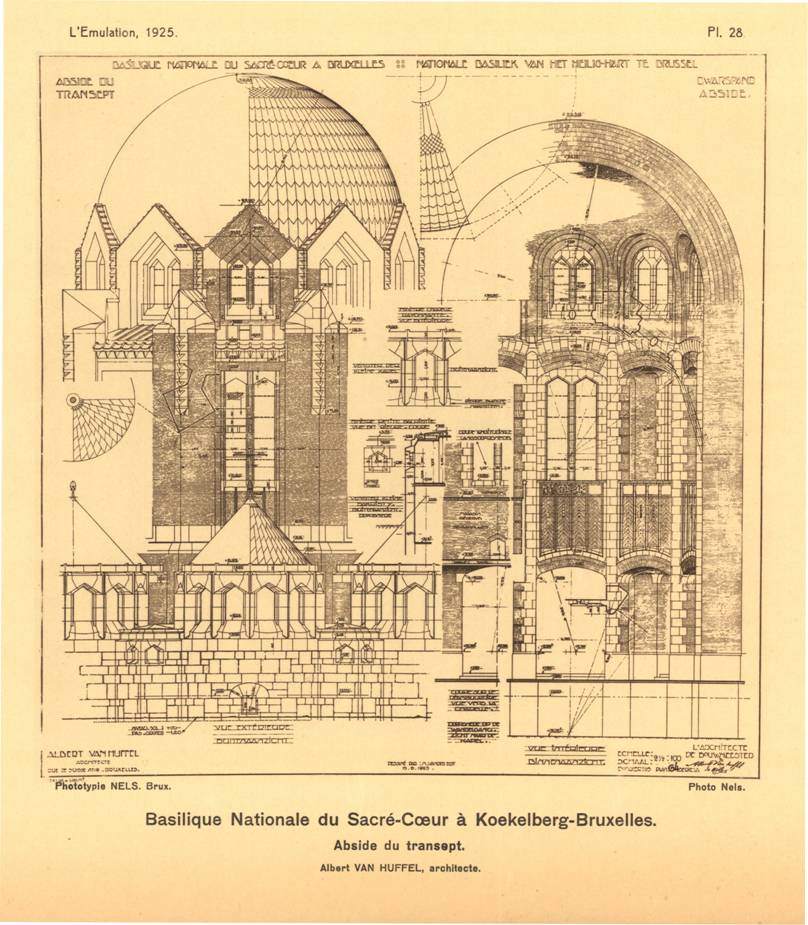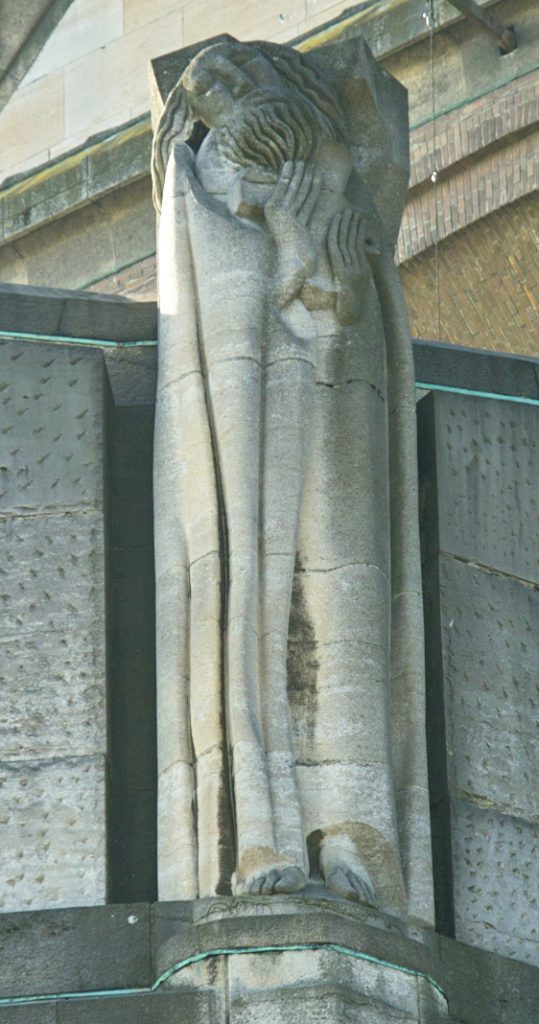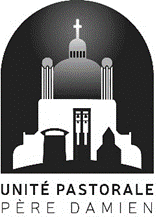The Basilica
The Basilica of the Sacred Heart in Koekelberg is a masterpiece of Art Deco.

Between the first designs of the Basilica, dating from the end of the 19th century, and the completion of the building lies almost a century. The building you can admire now is the result of a contemporary art expression, with the desire of – like in the Renaissance – approaching eternal beauty.
The concept of this religious building could only have been realised thanks to the cooperation of the architect Albert Van huffel, the engineer Paul Rome and the sculptor Harry Elstrøm.
© Wim Robberechts
Befriended basilicas:
Basilique du Sacré-Coeur de Montmartre https://www.sacre-coeur-montmartre.com/
History
It was the dream of our first kings to build at the plateau of Koekelberg a “Royal District” . At the end of the government of Leopold I, we already find plans and sketches for its construction.
In the framework of the redevelopment of the Elisabeth park and following the example of Paris, King Leopold II had been playing with the idea since 1880 of building a national Pantheon at the end of a long avenue on the Koekelberg plateau, on the occasion of the fiftieth anniversary of the independence of Belgium.



As he was so impressed by the ‘Basilique du Sacré-Coeur’ in Paris, he opted for a religious building. In his book Léopold II, Souvenirs des dernières années (1901-1914) E. Carton de Wiart writes:
‘There is a mountain of Justice, and over there in Koekelberg we need the mountain of the good Lord and here we need the mountain of Art.’ Besides Poelaert’s Palace of Justice, King Leopold II imagined two other architectonic beacons in the city.
Only twenty-five years later, on the 12th of October 1905, King Leopold II would lay the first stone of the national basilica. The first design (1903) by Pierre Langerock, planned a massive building in Neo-Gothic style, to the example of Eugène Viollet-le-Duc’s ‘ideal cathedral’.
When World War I broke out, only the groundwork had been finished. In his Christmas message in 1914, Cardinal Mercier gave a new meaning to the church: “As soon as our country knows peace again, we will rebuild our houses and we hope that as a coronation of this rebuilding, we can found a National Basilica of the Sacred Heart at the highest point of our capital.”
On the 29th of June 1919, this promise was confirmed by the authorities of the country and a large crowd. Due to the worsened financial situation after the war, Langerock’s design was put aside.
Albert Van huffel, from Ghent, was proposed as architect by Dom Sébastien Braun from the abbey of Maredsous and he was accepted under the pressure of Cardinal Mercier. Van huffel was awarded the Grand Prix for Architecture with a scale model (1/40) at the ‘Exposition Internationale des Arts Décoratifs et Industriels Modernes’ in Paris in 1925. Since then, the monument grew step by step thanks to its promoter and, after his death the 16th March 1935, his right-hand Paul Rome (┼ 7 June 1989)

The adjustments and extensions of the foundations were started in 1926 and in 1930 they started to erect the apse, which eventually opened for worship in May 1935. The base of the dome was ready when World War II broke out. The works were not resumed until September 1944. The large nave was finished by 1951.
The church was consecrated by Cardinal Van Roey on 13 and 14 October 1951. Pope Pius XII assigned it the title of ‘Basilica Minor’ on 28th January 1952.
In 1953 the two towers were finished. The southern aisle was opened to the public in 1958 and the northern one in 1962.
Seven years later, in 1969, the large dome was finished. On the 11th of November 1970, a big ceremony for the 25th jubilee of Cardinal Suenens crowned the completion of the Basilica.
The Architect

After the rejection of the Langerock project after World War I (due to the high production costs), the architect Albert Van huffel (°Ghent 1877 – ┼ Tervuren 1935) was asked to design the Basilica of the Sacred Heart.

Due to his modest origin, Albert Van huffel combined his studies of Expressive Arts in the Royal Academy of Fine Arts in Ghent out of necessity with an education in several practical skills. Afterwards, he settled as an independent architect and decorator. From 1918 till 1925, he was artistic director of the company “l’Art Décoratif Céline Dangotte” in Brussels. He was also head of the ornament course at the Higher Institute for Decorative Art in Brussels.
The early work of Van huffel was eclectic, but in the 1920s there was an important evolution. Simplicity and geometry had become the most important characteristics of his work. Van huffel is looking for a coherent, functional and beautiful aesthetic, in which furniture, decoration and architecture are integrated.
In 1921, his first project for the basilica was ready. With his scale model (1/40) of the basilica he won the Grand Prix for Architecture at the Exposition Internationale des Arts Décoratifs et Industriels Modernes in Paris. You can still see the model in the basilica.

After the death of Albert Van huffel in 1935, his assistant and successor, engineer-architect Paul Rome, continued the project. He changed hardly anything to the design. He only made a few technical improvements and some modifications at the cupola.

The Monument
The Basilica of the Sacred Heart is a wonderful Art Deco Monument.
The Architect, Albert Van huffel, left no unused space in the Basilica: the huge church has space beneath it for meeting rooms, a crypt, a theatre, a weekday chapel, accommodation for the caretaker, in other words… a city within the city!

In this chapter, you will find more information about Art Deco, the Stained Glass, Sculptures and the Liturgical Furniture and Crockery of the Basilica.

Art Deco
The architect Albert Van huffel was looking for the deeper meaning of ornaments in architecture. His life’s work, the creation of the national basilica of the Sacred Heart, is therefore the most honest and interesting Art Deco building in Western Europe.
The Art Deco features consist of clear and straightforward lines, composed of compact and simple volumes in brick, stonework and natural stone. The building’s structure is completely made of reinforced concrete, using glazed terracotta as permanent framework.

The glazed terracotta as a decorative element inside the building creates a specific warm atmosphere, in spite of the chilliness of the material itself.

Stained Glass
The first stained glass in the basilica was installed in 1937. The collection of stained glass grew gradually with the construction of the basilica, as the donations of the religious, the Christian organisations and societies followed. The designs were put on carton by ten of the best stained glass artists who worked in our country halfway the 20th century. The quality of the stained glass is therefore very diverse.


The theme of the stained-glass in the apse is the Eucharist and the adoration. In the big nave the life of Jesus is told, as in the galleries the eight salvations, are the subject of the stained glass. Afterwards, stained glass was also put in the side chapels.
The most important artists that co-operated are Anto-Carte, Louis-Charles Crespin, Jan Huet, Michel Martens, Jean Slagmuylder, Maria Verovert and Pierre Majerus (pictures).
Above the main entrance sits Anto Carte’s imposing work, “The Adoration of the Lamb of God and the Last Judgment.”
Sculptures
The new religious architecture designed by Albert Van huffel, functionally disposed of the unnecessary, foresaw from in the beginning an impressive ciborium for the main choir, and a marble altar for the parochial part with a sculpture of the Sacred Heart.

Two famous artists, George Minne and Harry Elstrøm, made sculptures for the basilica. They represent two different traditions in the Sculpture art, which were confronted with each other due to the slow construction of the basilica.
George Minne
George Minne was born in Ghent in 1866 as a son of an architect. From 1882 till 1884 he studied in the Academy of Fine Arts in Ghent and he focused on the painting of biblical subjects. Thanks to his friendship with Maurice Maeterlinck, he was introduced in the symbolic school.


In 1898 he moved to Sint-Martens-Latem, where he will live until his death in 1941, with the exception of a stay in Wales during World War I. He was a member of the innovative Belgian group of artists “Les XX” (Les Vingt).
For the Basilica of Koekelberg, Minne made the sculpture of the Sacred Heart for the altar in the apse. He also made the bronze calvarie at the outside of the basilica.
Harry Elstrøm
Harry Elstrøm (1906-1993) was born in Berlin in 1906 as the son of a German industrial and an English author. He studied art and history of art in Dresden, Rome and Brussels. In 1934 he settled as an independent artist in Brussels. Elstrøm is known above all for his innovative work in religious art. In 1940, he became teacher in sculpture in the Saint-Lucas Institute of Brussels, and in 1952 he started teaching at the faculty of Applied Science at the Catholic University of Leuven.




The impressive sculptures Harry Elstrøm made for the basilica are expressionistic. The sculptures fit very well with the concept of the basilica and accentuate its grandeur.
The most important work of Elstrøm for the basilica is the majestic calvarie with the four angels above the ciborium of the main choir.
The sculptures of the four evangelists at the outside of the basilica above the narthex are also made by Elstrøm.
Liturgical Furniture and Crockery
In the developmental stage, the liturgical furniture was very decorative, but in the 1930s, the designs were more sober and majestic. The baptismal font of the basilica is made following the design of Albert Van huffel, many years after his death. It’s a last tribute to the genius of Van huffel, who sacrificed part of his life and his career to the National Basilica of Koekelberg.

Van huffel did not leave instructions for the design of a coherent collection of liturgical crockery. The collection of the basilica was completed throughout the years with objects that were given for special occasions in the basilica or objects which arrived here by coincidence. It’s a unique collection because the items date almost exclusively from the 20th century. The most beautiful and original pieces were made in the 1930s in the workshops in Brussels from Camille Colruyt, Devroye Frères and Henri-Joseph Holemans.
A part of the liturgical crockery can be seen in the Museum of the Black Sisters.

